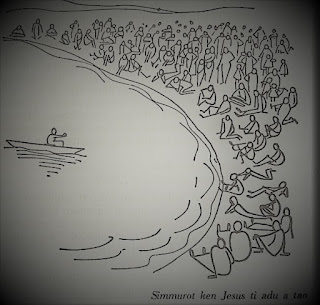The First Good Friday: Notes on the Death of Jesus in Mark's Gospel
Please don't forget to subscribe to our YouTube channel Biblical Apostolate PH
The Gospel of Mark is said to be the earliest written gospel. The evangelist has the oldest narrative of the first Good Friday, presumably.
The Road to Death
After the Last Supper, Jesus and his disciples go out to the Mount of Olives, a high hill in the east of Jerusalem, a place where Jews believed God will return someday (Zech 14:4.10).They proceed to Gethsemane, where he prays in isolation. Three times he asks the Father to take the cup from him—a cup of suffering which earlier he had challenged his disciples to drink (10:39)!
In the utter silence of the night (God is silent and the disciples sleep soundly), Jesus accepts God’s will.
Judas comes with armed men (swords and clubs) and greets his master with a kiss (Judas turns the kiss from a symbol of friendship to a symbol of death).
After an unnamed sword-wielder cuts off the ear of the high priest’s servants--symbol of the violence that is to come--all of the friends of Jesus desert him and flee (14:50), including a young man who is following Jesu. He runs away naked.
This young man embodies failure: those who had left everything to follow him in Galilee (1:16-20) now left everything to get away from him.
The arresting party hands over Jesus to the chief priests, elders, and scribes (the so-called “Sanhedrin”) to determine his fate (Jewish trial, 14:53-15:1.
The scene is dramatic. As Jesus boldly confesses that he is the Son of God, Peter curses him and denies knowing him. Ironically, at the very moment, Jesus is being mocked as a false prophet, the third of his prophecies about the failures of his disciples is being fulfilled ("nagkakatootoo").
The Jewish authorities hand over Jesus to Pilate (Roman trial, 15:2-2:20a). Pilate asks Jesus on the charge that he is the “Messiah, and King of the Jews,” apparently, these terms contain revolutionary meaning.
Pilate knows that Jesus was handed over out of envy. As Jesus was mocked as a prophet in the Jewish trial, he is mocked as the King of the Jews in this Roman trial and by Roman soldiers.
Rejected by all, Jesus is handed over by Pilate to the Roman soldiers to be crucified.
The Death of Jesus
The climax of the passion narrative is Jesus' crucifixion, death, and burial (15:20b-47).
Before the crucifixion, on the way to the place called Golgotha, Mark highlights the help rendered by Simon of Cyrene, and after Jesus’ death on the cross, the help rendered by Joseph of Arimathea. Ironically the only ones who assist him are those who, so far as we know from Mark, had no previous contact with him.
Old Testament Echoes
The crucifixion details that Mark mentions are reminiscent of Old Testament descriptions of the suffering just one. Examples:
(1) The two wine drinks, with myrrh at the beginning and sour wine at the end (15:23) =
Proverbs 31:6-7 "Give strong drink to one who is perishing and wine to those in bitter distress; let them drink and forget their poverty, and remember their misery no more."
Psalm 69:21 "They gave me poison for food, and for my thirst, they gave me vinegar to drink."
Note that in Mark, Jesus refused to drink the wine mixed with myrrh. He refused to be “drugged;” he accepts totally with equanimity his suffering, “willing to die with an unclouded mind” as one biblical scholar writes (Vincent Taylor, The Gospel According to St. Mark, 1966).
(2) the division of the clothes (15:24) =
Psalm 22:18 “they divide my clothes among themselves, and for my clothing they cast lots.”
Three Periods
Three-time periods are indicated: the third, sixth, and ninth hours (9:00 am; noon; 3 pm), with an increasingly tragic coloring.
(1) In the first period, three groups are given a role at Jesus’ cross: passersby, chief priests and scribes, and co-crucified criminals. All of them mock him, indeed, by reviving the issues from the Jewish trial (destruction of the sanctuary, identity as the Messiah).
(2) In the second period, darkness comes over the land. The total eclipse of the sun may indicate that the whole universe joins in mourning the death of God’s Son. Or the sun simply refuses to shine to cover the naked Jesus on the cross as Melito of Sardis says (d. 180 A.D.).
(3) In the third period, Jesus speaks from the cross for the first and only time.
Note that Mark begins Jesus’ passion (14:36) with a prayer in Gethsemane, in transcribed Aramaic and Greek, “Abba Father…take away this cup from me.”
Mark closes Jesus’ passion (15:34) with another prayer, citing in Aramaic and Greek the desperate words of Psalm 22:2: “Eloi, Eloi, lama sabachtani…My God, my God, why have you forsaken me?”
Feeling forsaken and no longer presuming to use the intimate family term, “Father,” Jesus is reduced to a form of address common to all human beings, “My God” [“Diosko”]
Still, no answer comes from God. And Jesus dies.
God's Vindication
Theological Meaning of Jesus' Death
1. Why was Jesus killed? –a historical question about the causes of his death.
b. Jesus’ death as freely accepted and as an expression of justice and love, p. 116.


Comments
Post a Comment